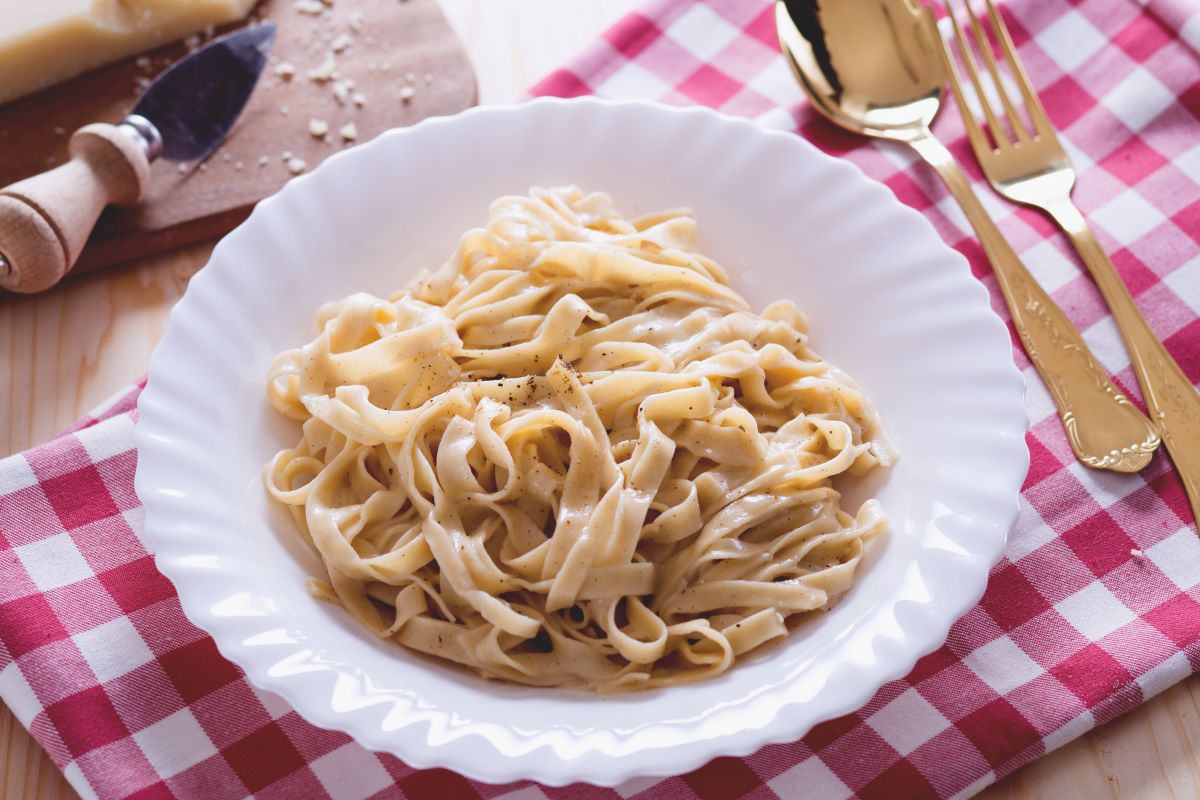Tagliatelle
- Average
- 30 min

Indulge in the rich, velvety goodness of Fettuccine Alfredo, a dish that has become a cornerstone of Italian-American cuisine. Featuring tender fettuccine pasta coated in a luxurious sauce made from butter, cream, and Parmesan cheese, this recipe is the ultimate comfort food. Perfect for weeknight dinners or elegant gatherings, Fettuccine Alfredo is a crowd-pleaser that’s as simple as it is satisfying.
Originally created in Rome by Alfredo di Lelio in the early 20th century, this iconic dish won international fame after being embraced by Hollywood stars in the 1920s. While the authentic Italian version skips the cream, the American adaptation has added it for extra indulgence, creating the creamy pasta we know and love today.
Fettuccine Alfredo are deeply Italian, just like Spaghetti all'Amatriciana or Spaghetti Cacio e Pepe: simple homemade egg pasta fettuccine tossed with ample butter and Parmigiano Reggiano PDO, embodying the simplicity and elegance of Italy's culinary traditions.
Try our easy-to-follow recipe to create restaurant-quality Alfredo at home, and discover why this creamy pasta is a favorite in kitchens everywhere!
If you're a fan of fettuccine, don't miss out on these other delicious ways to dress it up:

To prepare fettuccine Alfredo, start by making the fresh egg pasta: sieve the flour 00 in a bowl (perhaps start with a little less than the full amount of flour and add more if necessary) 1, and add the eggs 2. Knead by hand to obtain a homogeneous dough 3, then place it on a worktop and finish kneading; if the dough seems too soft, you can add a little more flour, if it appears too dry, moisten with a little water.

When the dough is firm and elastic, roll it into a ball and wrap it in plastic wrap 4. Leave to rest at room temperature for 30 minutes so that the gluten relaxes and the dough is easier to roll out. After half an hour, sprinkle a little flour 00 on the work top and divide the dough into 4 parts using a scraper 5: knead one part at a time and keep the remaining dough covered in plastic wrap so that it doesn't dry out. Lightly sprinkle some flour onto the part you are about to knead 6

and feed it into the pasta making machine, on the thickest setting 7; add a pinch of flour to prevent the dough from tearing 8. Repeat the operation several times, working your way up to the penultimate setting 9. If you do not have a pasta making machine, you can roll out the dough with a rolling pin; wrap the dough around the pin and unroll it several times, until it is a few millimeters thick.

Now divide the sheets of dough into 2 or 3 parts according to length 10 and feed them through the machine once more, on the penultimate number to prevent them from shrinking 11. Sprinkle the semolina over the pasta sheets 12 and leave them to dry for a couple of minutes. In the meantime, bring some salted water to the boil in a saucepan, to cook the fettuccine.

Once the pasta is dry, take a sheet and wrap it around itself from the shorter side, taking care not to press, so that the overlapping layers do not stick together 13. When you succeed in making a regular shaped cylinder, cut into roughly 4 mm thick slices using a knife 14. Unroll the slices, holding them by one end 15,

roll the resulting fettuccine around your hand to form a nest 16 and leave them to rest on the work top; proceed in the same way with the rest of the pasta sheets. When the fettuccine are ready, cook them in the water which will have come to the boil by now 17. As the pasta cooks, it'll only take 2-3 minutes, prepare the sauce: melt the butter on a very low flame in a capacious pan, but be sure not to burn it 18.

Add a ladle of pasta cooking water: the starch it contains will help you create an even creamier condiment 19. Drain the fettuccine and place them in the pan with the butter 20, add another ladle of cooking water 21 and briefly saute, stirring rapidly all the while.

Now remove from the heat and add the grated Parmigiano Reggiano 22; last of all, season with a pinch of salt 23 and a generous grating of black pepper; stir once more to thoroughly coat the pasta in the sauce. Your fettuccine Alfredo are ready to be served 24!